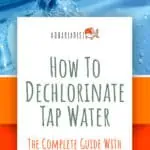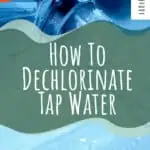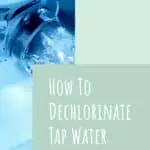If you put untreated tap water directly into your fish tank, you will most likely kill your fish pretty quickly! But why is tap water so dangerous to your fish, and how can you make it safe?
Keep reading to find out!
Key Takeaways
- Chlorine and chloramine found in tap water are toxic to aquatic life and disrupt the balance of beneficial bacteria in your aquarium’s ecosystem.
- Liquid dechlorinators are a convenient solution for making tap water safe for your fish tank; be sure to confirm that the product treats both chlorine and chloramine.
- Regular water testing is necessary to prevent toxic conditions in your aquarium; even dechlorinated water can contain other harmful chemicals like nitrates, which can sneak in from tap water.
What’s So Bad About Tap Water?
So, why is tap water so dangerous for your fish?
The tap water used for human consumption in most Western countries contains chemicals, including chlorine and chloramine, that your water treatment center adds. Although those chemicals are necessary to produce safe drinking water for people to wash and cook with, those additives are potentially fatal to fish and other aquatic life. Chlorine and other chemicals also kill the beneficial bacteria that live in your tank and biological filter system, further damaging your water quality.
Also, any level of chlorine and chloramine in water can affect your fish tank’s salinity and pH levels. These chemicals have no place in a healthy, thriving aquarium, and you need to remove them from the water you’re using during your weekly water changes and top-ups.
Bottom line: Before you add tap water to your fish tank or pond water, you need to make sure that all those potentially dangerous chemicals, such as chlorine and chloramine, are removed or neutralized by applying a dechlorination agent to the water.
Liquid Dechlorinator
The quickest and simplest way of dechlorinating your tap water supply for use in fish tanks and ponds is to use a liquid dechlorinator. Sometimes, tap water conditioners contain dechlorinators, but not always. So, always check the product label to ensure that you’re buying the right product.
You add the specified amount of dechlorinator to your tap water right before adding it to the tank. Not every dechlorinator neutralizes chloramine, so make sure that you’re using the correct product. Your local authority should be able to tell you what your tap water contains. However, if you’re not sure, always play it safe and choose a dechlorinator that covers both chlorine and chloramine.
It’s not generally possible to overdose your tank with dechlorinator, but if you’re unsure what the exact volume is, adding a little more won’t harm your fish. You can usually add up to double the recommended dose of dechlorinator without causing a problem for your livestock.
Also, sometimes the chlorine levels and the amount of chloramine added to the water increase in line with local conditions. So, if your water smells especially strongly of chemicals, it probably won’t do any harm to add a little extra dechlorinator to protect your fish.
You can buy a range of good-quality dechlorinators from good fish and pet stores and online.
- Contains one (1) API TAP WATER CONDITIONER Aquarium Water Conditioner 16-Ounce Bottle
- Neutralizes chlorine, chloramines and other chemicals to make tap water safe for fish.
Test Your Aquarium Water
Before you add any water to your fish tank, you must test it to ensure that it contains no chlorine or chloramine. You can do that with a proper aquarium water testing kit or chlorine test kit.
Ideally, you want to test your aquarium water every week to ensure that toxic ammonia and nitrites are at zero and nitrates are below 20 ppm.
At the same time, I recommend testing your tap water before adding it to the tank. I recall an incident one time when my fish began showing signs of nitrate poisoning. I tested the tank water and discovered that the nitrate levels were too high. I was horrified because I’m always so diligent and careful with tank maintenance and cleanliness.
I couldn’t understand why. So, I tested my tap water. Imagine my dismay when I found the nitrate levels in my tap water well exceeded 20 ppm! The moral of the story is not to assume that tap water is safe once you’ve dechlorinated it.
Interestingly, some contributors on Reddit agree. There are reports of high nitrates and other harmful chemicals in tap water in different parts of the country, so it’s worth checking. However, some posters believe that not all aquarium water test kits are accurate, so be sure to use a high-quality one that delivers the results you need.
Natural Treatments
Many aquarists don’t like the idea of adding even more chemicals to their fish tanks to remove chlorine and chloramine from tap water. Also, some fish and invertebrate species are quite sensitive to chemical additives, so you might want to take a more natural, chemical-free approach to water dechlorination.
There are several ways to do that, and we cover those options in this section of our guide.
Gassing Off Chlorine
If you’re confident that your tap water only contains chlorine, you could take the old-school route and remove the chemical by gassing off the harmful substance.
Chlorine is a gas added to water in liquid form. So, by allowing a bucket of uncovered water to stand for a while, ideally a minimum of 24 hours, and stirring it periodically, you will encourage the liquid chlorine in the water to evaporate into the air as a gas. Unfortunately, most water treatment companies have moved from using chlorine to another chemical called chloramine in recent years.
Chloramine is chlorine bound with ammonia. Unlike chlorine, chloramine doesn’t convert to gas. That means that even though gassing off the water will remove the chemical’s chlorine element, the ammonia will be left behind. Ammonia is also highly toxic to fish, causing chemical burns to the fish’s gills and quickly killing them, so you don’t want that in your aquarium.
Boiling
A simple way to purify chlorinated water is to boil it for 20 to 25 minutes. That’s generally sufficient to remove the volatile chlorine from the water. However, boiling the water is not as effective at removing chloramine from water.
Also, remember that you’ll be changing up to 25% of your water every week. That’s a lot of water to boil if you have a 20-gallon aquarium or larger! So the practicality of this method generally rules it out.
In theory, you could use the boiling method if you only have a small nano tank. However, you still need to wait for the water to cool to the desired temperature before adding the clean and chlorine-free water to your tank, or you risk cooking your poor fish!
Ultraviolet Light
Using ultraviolet light rays is another natural way of removing chlorine from tap water, which is also an effective method to neutralize chloramine.
You can buy a UV light source for your fish tank relatively inexpensively. Many aquarists use UV lights to kill harmful bacteria and subdue algae bloom in the tank. If you already use a UV light, that will also eliminate all the chlorine and chloramine, assuming that the light is powerful enough. Alternatively, if you live in a very warm, sunny climate, you can put a bucket of water outside in direct sunlight for 24 hours.
The main downside of taking that approach is that you might end up with other harmful contaminants in the water, especially if you live in a rural area where crop spraying and the like occur. Also, it will take more than one day to obtain sufficient sunlight to sterilize the water thoroughly, and there could also be an issue with the volume of water you need.
Vitamin C
No doubt you already know that you can ward off colds, flu, and even plague by taking vitamin C. Vitamin C is also found in citrus fruits and should form a part of your diet year-round.
However, did you know that vitamin C is also an efficient water purification method for your fish tank?
You can use vitamin C to neutralize chlorine and chloramine in tap water before you add it to your fish tank. Just add one teaspoon of ascorbic acid (vitamin C) for every gallon of water that you want to use for your fish tank. Alternatively, you can use vitamin C tablets in the same ratio.
Although it’s a potentially simple and cheap solution for purifying tap water before adding it to your tank, vitamin C can affect the pH levels of the water. For that reason, we recommend that you ask questions in your local fish store before you go down that route.
Carbon Filter
Some hobbyists rely on a simple carbon filter as an effective tap water dechlorination method.
An effective filter will remove many other contaminants and organic compounds from water, including heavy metals and chemicals that could harm your fish. If you use medication to treat fish diseases, you must remove the carbon filter from the tank, or it will extract the medicine from the water.
That’s why we always advise that you set up a hospital tank or quarantine aquarium if you intend to use chemicals or drugs to treat your fish or plants.
However, to treat tap water before adding it to your aquarium, you would need to install a carbon filter in a separate tank, treat the water, test it, and then transfer it to your main display aquarium. That’s a time-consuming, laborious endeavor, and it’s not the most practical solution.
Final Thoughts
We hope you enjoyed this guide explaining some of the methods that you can use to dechlorinate tap water before adding it to your fish tank.
Of all the methods outlined above, the simplest, cheapest, and most effective way of removing harmful chloramine and chlorine from water is to use a high-quality dechlorinator or “tap safe” chemical treatment that you can buy from all good pet and fish stores and online.
Whatever method of dechlorination you decide to use before adding any tap water to your fish tank, we advise that you test the water to ensure that the levels of chlorine and chloramine are zero.














